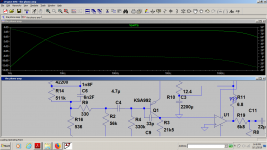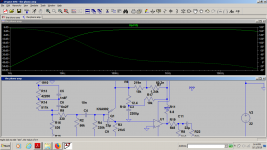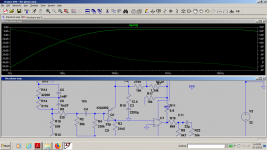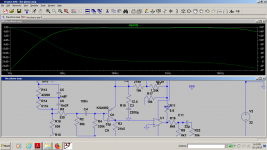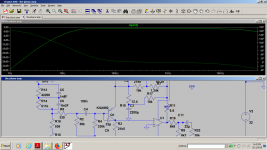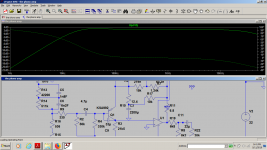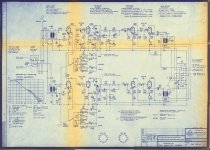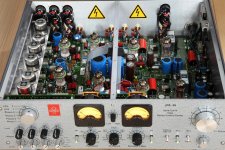... Rumble? Haven't noticed it in the last 50 years. Is there still some in a quality turntable?
I did.
I bought a Lenco L75, idler drive, in the early 70's, long before that thing achieved cult status; the rumble was clearly audiboe, borderline annoying. I then traded it against a Thorens TD150, belt drive, rumble gone.
In the mid 70's, I bought, cheap, a Thorens TD124 which was on its way to achieving cult status; it had both belt and idler wheel drive, the worst of both worlds, plus a magnetic steel platter. The rumble was back, as clearly as with the Lenco, plus some extra annoyance because of the platter. I listed it on the local classified for $400, a guy immediately came over, breathing heavily, dropped the $, grapped the TT and ran. That made both of us happy.
In the late 70's, I bought a Linn LP12 direct from Linn, belt drive, no more rumble, and we've been living happily ever after.
Unfortunately too many people think of themselves ad audio guru in a domain where the RIAA standard simply solved all the problems for all of us. Just see what a smart thing we can do with the kl02-aiwa c-22 theoretical combination preamp when adding or removing the subsonic integrating filter (lt1115 like)plus or minus modifying the input coupling capacitor value.
Lowering the input capacitor value also allow us to use higher quality film capacitors with infinitesimal dielectric absorption too just to keep JC around 🙂
You can be defiant , but i spent years checking most commercial models and high end audio claims and there is no best solution. You can do it by ear and still have a decent riaa preamp just because of the RIAA standard itself. I even modified a passive riaa filter to have a Presence-deesser tone control.That was done in the 1v2 preamp by having R23 and R25 forming one single 470 ohms wirewound potentiometer getting me +-5...+-8db between 5...7khz . You can tolerate large amounts of non linearities with vinyls as they are very nonlinear by default.
Lowering the input capacitor value also allow us to use higher quality film capacitors with infinitesimal dielectric absorption too just to keep JC around 🙂
You can be defiant , but i spent years checking most commercial models and high end audio claims and there is no best solution. You can do it by ear and still have a decent riaa preamp just because of the RIAA standard itself. I even modified a passive riaa filter to have a Presence-deesser tone control.That was done in the 1v2 preamp by having R23 and R25 forming one single 470 ohms wirewound potentiometer getting me +-5...+-8db between 5...7khz . You can tolerate large amounts of non linearities with vinyls as they are very nonlinear by default.
Attachments
Last edited:
+1
Dadod made an original design, very inspiring, with impressive results, shared his work for free with all the schematics etc., very helpfull, in the perfect good practice of DIY, and now, he is flamed for talking about ?
I love you too

I told you exactly what I did to get the earlier plot. I ran a 20k resistor from the output of an all active RIAA phono EQ amp to the junction of the bottom of the gain setting resistor (75 Ohms) and the top of the DC blocking cap (470uF). That's all - nothing else. See the LT1115 phono amp schematic Mark Johnson posted if you want more detail on the technique.
re the GD, LTspice is your friend. Click on the right vertical axis and select 'display Group Delay' - that's how I got the numbers I mentioned re the above. Additionaly, See fig 7 in the Holman paper where hearing sensitivity to GD is shown.
If you are fixated on the +2.5dB peaking between 100 Hz and 20 Hz on a phono EQ and not worried about things like speaker-room interaction or cart response then you indeed have a problem of priorities. But if its such a concern, then just don't do it or switch the filter out.
And no, I don't believe cart response anomalies are an excuse for sloppy design - the EQ amp is flat to within 0.2 dB before I connect the 20k resistor as described above.
Duly noted, so you couldn't care less about the LF RIAA accuracy, don't care about the sensitivity of the bootstraping peaking and the interaction with the LF amplifier frequency response, simulated only without any GD measurements (highly dependent on the sensitivity), you say cartridges have worse than 2dB low frequency response, then take it back, then once again claim the speaker-room interaction is more important, have happy customers. Tell you what, in my book this is as close to "design by ear" as it gets. Case closed.
BTW, if not already obvious, the technique to boost the LF response is well known, called bootstraping, and can be implemented without peaking, if carefully designed (not in your case, unfortunately) to mix and match with the amplifier LF pole. It can extend the LF frequency response, but it implements a single pole, though, so the effect on rumble (about 7Hz) is virtually zero. Try an idler wheel turntable with it, you will lose some Garard lover customers.
And by the way...if you really want to understand how a phono preamp-cartridge should behave you better find the EMT JPA-66 schematic!
I don't want to understand such a 50 years old monstrosity. Not being in the audio business (not even a wannabe), I can afford to. With all those transformers, I'm sure it sounds great

Attachments
That schematic is for emt-139 not jpa-66I don't want to understand such a 50 years old monstrosity. Not being in the audio business (not even a wannabe), I can afford to. With all those transformers, I'm sure it sounds great
http://www.audeus.it/wp-content/uploads/2015/07/JPA66_75.jpg
you don't need to ...there are others who can do it , but EMT set the standards for the rest of us...I don't have the jpa 66 either, but i don't need to...I found their small secrets already.
And be happy cause it's current feedback design with valves 😉))))
Attachments
Last edited:
Duly noted, so you couldn't care less about the LF RIAA accuracy, don't care about the sensitivity of the bootstraping peaking and the interaction with the LF amplifier frequency response, simulated only without any GD measurements (highly dependent on the sensitivity), you say cartridges have worse than 2dB low frequency response, then take it back, then once again claim the speaker-room interaction is more important, have happy customers. Tell you what, in my book this is as close to "design by ear" as it gets. Case closed.
BTW, if not already obvious, the technique to boost the LF response is well known, called bootstraping, and can be implemented without peaking, if carefully designed (not in your case, unfortunately) to mix and match with the amplifier LF pole. It can extend the LF frequency response, but it implements a single pole, though, so the effect on rumble (about 7Hz) is virtually zero. Try an idler wheel turntable with it, you will lose some Garard lover customers.
😀
I dont know if the "bad" output one is in or out of compliance. The issue I am more concerned with is having this much HF going to the audio IC opamp and then out to a power amp. Not many audio amps can handle such HF cleanly and amplify it another 30dB or so.
To get out of the DAC, it has already gone through, in AKM case, (Cmos)
opamps and in Sabres case, I-V opamps. If there's any sonic damage, it will have already happened.
Its amazing to me that so many designers dont seem to notice this or think it is just fine to send it/HF thru. Its only -55db down +30 db PA gain ..... !
THx-RNMarsh
I know at least one manufacturer that uses just 1 VHQ transformer at the OP sans other opamps. If this wins subjectively against active stages with aggressive LP filtering, there's your answer.
The problem with this thread is there are too many so called experts but very few people who actually build and listen to all of these different designs that come under scrutiny.
T
Thank you Zung for your informative input. I once had a rumble producing turntable, a RekoKut in 1963, used. It DID rumble, but in 1968 I switched to a Thorens TD150, and I don't remember any rumble, then in 1974, I got my first Linn, and I have never had any trouble with rumble. I do understand that some people want and need some sort of rumble filter, but I try to avoid them in my best efforts.
Last edited:
Thank you Zung for your informative input. I once had a rumble producing turntable, a RekoKut in 1963, used. It DID rumble, but in 1968 I switched to a Thorens TD150, and I don't remember any rumble, then in 1974, I got my first Linn, and I have never had any trouble with rumble. I do understand that some people want and need some sort of rumble filter, but I try to avoid them in my best efforts.
Oh, yes! Your best effort is trying not to provide a solution for a minor electronic problem. The one and only high end solution is to buy a "better" TT, arm and cartridge until
it happens to fit, and to iron the warps from the vinyl.
Hey, I have seen a solution where they sucked the disk to the platter with vacuum.
I have a classic RCA 16" turntable converted to stereo. Rumble is built in from the very start. But it is what you need to transcribe recordings from before Ampex started making tape recorders.
The older records were played first one from the outside to the center and then the next in the series was played from inside to the outer edge. That was done so folks would not notice the change in fidelity.
The older records were played first one from the outside to the center and then the next in the series was played from inside to the outer edge. That was done so folks would not notice the change in fidelity.
Just the way the engraving machines works. It flattens the veiled discs and dump resonances of the vinyl. Expensive, but not a bad Idea.Hey, I have seen a solution where they sucked the disk to the platter with vacuum.
The older records were played first one from the outside to the center and then the next in the series was played from inside to the outer edge. That was done so folks would not notice the change in fidelity.
There's a lot out there on film sound on 16" LP's and syncing it to the film, never saw anything about that, but as usual you know more about everything than anybody.
Last edited:
I was talking of durst making stain on the photo, as you we have on near each one with captors if we are used to change lenses.
I had less problems of durst with "ultrasonic" (Olympus like) than with my Canon and Sony, but it is always a boring problem.
I don't had so many problem with durst in my little lab at that time. Film is easy to clean in the lab, and, in 35mm, the cartridge is durst free. it can affect one photo, not all of them, like in digital.
In the wet proces, I was always battling dust. Drying negatives.....brrr. I agree that earlier generations like the Canon 5D Mark I had issues, but in later issues like the Mark III these have been completely solved in my experience.
Engraving discs is one thing, playing them is another one...Just the way the engraving machines works. It flattens the veiled discs and dump resonances of the vinyl. Expensive, but not a bad Idea.
Please stop advertising your stuff in this thread. You have your own thread (actually several) for this.
Contrary to that I would like to thank Dadod for posting it on this thread, I would have missed it otherwise. In addition, a statement was made that is pertinent to a discussion we had in this thread: CFA versus VFA. My own position in this is utterly utilitarian: whatever provides the best solution for a given design spec. For others it appears to be a more principled matter.
So, my question to Dadod would be: why did you convert from CFA to VFA?
In general I applaud all participants in this thread who show their work. All the more so those who produce at professional level without profit motive.
Last edited:
Scott,
You do know about the dots in the upper right hand corner of the movie frames?
ES
The queue dots of course I spent years as a projectionist. the delay between sound and picture was set by a standard to keep everything synchronized. Two sets, at the first you turn on the second projector at the second you switch the gates, you can't get me on this I did it for years.
Last edited:
Contrary to that I would like to thank Dadod for posting it on this thread, I would have missed it otherwise. In addition, a statement was made that is pertinent to a discussion we had in this thread: CFA versus VFA. My own position in this is utterly utilitarian: whatever provides the best solution for a given design spec. For others it appears to be a more principled matter.
So, my question to Dadod would be: why did you convert from CFA to VFA?
In general I applaud all participants in this thread who show their work. All the more so those who produce at professional level without profit motive.
To convert this CFA to balanced inputs I added inverted input with H-bridge, and as consequence it became VFA. It still keeps all important CFA attributes.
For those who don't have the T. Holman article razored out of the old magazine, it's available at: AUDIO - Consumer audio and music magazine from 1947 to 2000. Choose July 1977, scan to page 72.
It's strange to see folks who came up in the CD era trying to re-fight so much engineering that was settled doctrine decades ago.
Believe it or not, good solid engineering occurred before the internet. Strange, but true.
All good fortune,
Chris
It's strange to see folks who came up in the CD era trying to re-fight so much engineering that was settled doctrine decades ago.
Believe it or not, good solid engineering occurred before the internet. Strange, but true.
All good fortune,
Chris
Oh, yes! Your best effort is trying not to provide a solution for a minor electronic problem. The one and only high end solution is to buy a "better" TT, arm and cartridge until
it happens to fit, and to iron the warps from the vinyl...
That is correct.
JC is into high end audio design; I also believe it's the purpose of this thread. You can't sensibly expect anyone in his (her) right mind to mate an all-out electronic design effort with any old, rumbling and grunting pieces of junk, be it turntable, loudspeakers, etc.
Just like Thai cuisine, balance is the secret word. In order to achieve that, you need at least some understanding of the other components, e.g. hooking a trailer to a Lambo is not generally a good idea.
- Status
- Not open for further replies.
- Home
- Member Areas
- The Lounge
- John Curl's Blowtorch preamplifier part III
